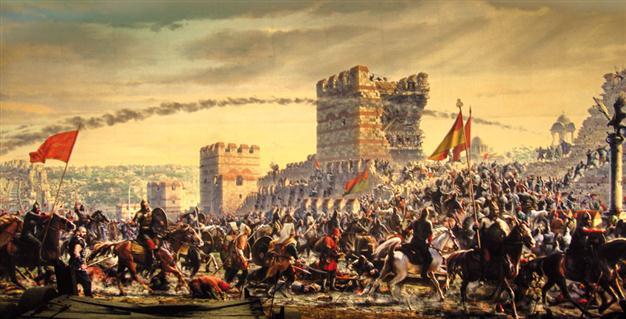 Fetih 1453 is the latest historical blockbuster to hit the Turkish cinema screens. In it, the Ottoman Turks conquer Constantinople, Constantinopolis, the city of Constantine, the capital of the no-longer-in-existence Eastern Roman Empire. Although the Roman Empire in the East had ended centuries earlier, the inhabitants of the city liked to remind themselves of past glory by calling themselves Romans.
Fetih 1453 is the latest historical blockbuster to hit the Turkish cinema screens. In it, the Ottoman Turks conquer Constantinople, Constantinopolis, the city of Constantine, the capital of the no-longer-in-existence Eastern Roman Empire. Although the Roman Empire in the East had ended centuries earlier, the inhabitants of the city liked to remind themselves of past glory by calling themselves Romans.The victory was mostly symbolic though, since the Ottomans had long held the territory that surrounded the slowly dying city. Although the Europeans thought of the city in terms of greatness and fabled wealth, that had long disappeared — taken west by the participants in the Fourth Crusade who had decided that conquering and plundering this rich city in the 13th century was more attractive than risking one’s life on the chancy business of recovering Jerusalem from the Arabs. For three days in 1204, the city was the scene of murder, rape, plunder and sacrilege.
Views of historians
Various prominent western historians like Speros Vryonis and Sir Steven Runciman have described the event as one of looting, rape and murder so horrendous as to be almost unbelievable. Artwork, relics, gold and silver – anything that could be carried off – either went west to the Pope or Venice, or stayed in the pockets and pouches of knights who chose to return to their homes in Europe. The Greek residents of the city who hadn’t been able to escape were either killed or enslaved. The Hippodrome was destroyed, and the sanctity of St. Sophia cathedral violated. The Palaiologoi family was restored to imperial power in 1261, but nothing could restore the grandeur that Constantinople had once enjoyed.
During the nearly two centuries before Fatih Sultan Mehmed’s coup de grace, there were several attempts by the Ottomans to take Constantinople, as the Ottoman Turks expanded their influence and territory. Areas cultivated to feed the city fell in the hands of large landowners who could charge whatever they wanted and didn’t mind selling to the Turks.
Cities like Venice and Genoa saw no difficulty in trading with the Turks, as trade in the Mediterranean, Aegean and Black Seas was no longer in the hands of the Byzantines. Tax revenues on which the Byzantine government relied were radically reduced and the state treasury had to pay out huge sums to keep its military going. There were, in addition, bribes to be paid to keep its allies faithful, dowries for marriages and other calls upon the public purse. The city still owed a large sum of money to Venice when it was finally conquered.
The facts of the city at the 11th century
The population, which had been around one million in the 11th century when the city was at its height, had fallen to 50,000 or possibly even fewer by 1453. Many of those remaining were poor and in ill-health from lack of a proper diet. In the end the only food available had to be brought in by boats running the Turkish naval blockade, and that eventually proved impossible. In fact, the population was so small that Fatih had people brought in from the provinces, so that there were enough people to make the city work.
The five miles of city walls had to be constantly repaired, and they often were with shoddy materials, right up to the fall of the city. The Great Palace which was located along the eastern side of St. Sophia and Sultan Ahmed Camii all the way down to the seawalls on the Marmara Sea were abandoned. The imperial family established their main residence in the palace of Blachernae, of which the Tekfur Saray today is the only remaining part. Only three monuments which we still see today remained standing in the Hippodrome.
The lengths to which the Palaiologoi would go to retain their imperial throne were considerable. The sacking of the city by the Crusaders who were, at least nominally, faithful to the Roman Catholic Church, led to an irreparable breach with the Eastern Orthodox Church to which the Greeks belonged. Nothing could have turned the Greeks more against the last emperors than the latters’ acceptance of Roman Catholicism in their attempt to get reinforcements from the West to stave off the Ottomans. The Pope in Rome denounced the sacking of the city until he received a share of the plunder. After that he turned sympathetic to the Crusaders. [Only in recent years has there been an attempt to reconcile the two churches.]
The emperors used their daughters and sisters as bargaining chips to gain allies with the daughter of the Palaiologos who ruled over the Peloponnese, actually spending time in the harem of Fatih Sultan Mehmed II. The imperial family in the end was related to the Bulgarian, Georgian and Serbian royal families and rather more distantly to the emperors of Austria and the Tsars of Russia.
The last emperor
In the end, the last emperor Constantine XI had only 13 ships and fewer than 10,000 men with which to defend the city. Of those 10,000 it seems that half or more were not Greeks, as anyone who could make it out of the city before the formal siege actually began did.
The Constantinople that Fatih Sultan Mehmed II conquered on 29 May 1453 was far cry from the imperial capital that it had been at the height of its glory. The city was only an empty symbol that the Ottomans were to bring back to life.